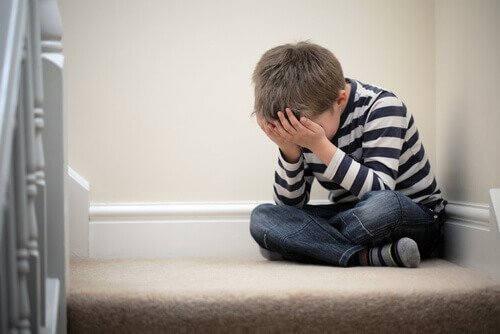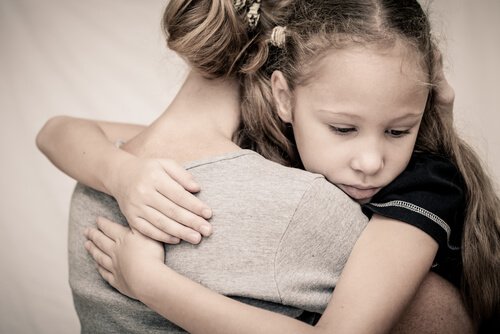Five Ways to Reduce Anxiety in Children

Children can experience very intense anxiety because they don’t have the same resources adults do to manage it. That’s why they need our help. In this article, we’ll discuss some strategies that can help reduce anxiety in children.
The first step is to evaluate if the child is really suffering from anxiety, as it’s a complex emotion with many causes. It can be very frustrating for children because they aren’t mature enough to control it.
What causes anxiety in children?
Many things cause anxiety in children, such as responsibilities, interpersonal relationships, and schoolwork. One common cause of childhood anxiety is separations or divorces.

When children start to leave the house without their parents, whether to visit relatives or start school, they might experience separation anxiety. In these situations, what starts as a kind of superficial tension can transform into intense anxiety when there’s nothing to diminish the sense of danger that the child feels when they’re separated from the people who protect them.
Another source of anxiety is contact with strangers (colloquially known as “stranger danger”). This is directly related to separation anxiety.
The important thing is knowing how to identify if a child is experiencing clinical anxiety or not. This can be difficult because although most children experience some degree of separation anxiety and stranger danger, that doesn’t necessarily mean they have generalized anxiety disorder (GAD).
Other more serious causes of anxiety are abuse, a violent or dysfunctional home life, the death of a loved one, a divorce, or a move. All of the things we mentioned above can lead to anxiety that a child is incapable of dealing with.
How to reduce anxiety in children
As we said before, the first step is to make sure that the child is suffering from anxiety and not just superficial stress. If you wrongly identify the problem, you might deprive them of the help they need or a challenge that could help them grow. Thus, you first have to identify the problem and its cause. Paying attention to how the child expresses their emotions is very important.
If you’re dealing with an isolated incident, the most important thing to do is try to reason with the child. Although it might not seem like it sometimes, children tend to be more adept at thinking rationally than we give them credit for. Having a conversation with them can provide some useful answers. This way, you can collaborate with the child to come up with a solution. This method is great because it positively reinforces reflection and reasoning.
Techniques to try
- Rational thinking is a good place to start. Reasoning with the child will help them concentrate, relax, and psychologically separate themselves from the problem.
- If the child isn’t able to find the appropriate words to describe how they’re feeling, make up a story about how they feel. It can be complicated for children to describe emotions that are new to them, which is why they need some help from adults.
- As we mentioned in the first bullet point, relaxation is very important. You can try different relaxation techniques or to objectively analyze their distress.
- Model emotional expression. Children learn a lot through imitation. Consequently, if you describe to them how you feel, you’ll help them improve their emotional vocabulary and their ability to describe how they feel.

In summary, here are the steps you should take to identify anxiety in children:
- Pay attention to the physical and psychological symptoms.
- Have a conversation with the child about their problem.
- Come up with a solution together.
- Use techniques that will help the child improve their mood.
- If the problem persists and it seems like something more serious than normal stress and anxiety, consult a specialist.
Children can feel anxious about many things, real or imaginary. Thus, adults have the responsibility to teach children positive ways to deal with the emotions that arise when faced with these perceived threats. Nowadays, children have a lot to deal with, which is why they need us to show them how to do it in a healthy way.
Children can experience very intense anxiety because they don’t have the same resources adults do to manage it. That’s why they need our help. In this article, we’ll discuss some strategies that can help reduce anxiety in children.
The first step is to evaluate if the child is really suffering from anxiety, as it’s a complex emotion with many causes. It can be very frustrating for children because they aren’t mature enough to control it.
What causes anxiety in children?
Many things cause anxiety in children, such as responsibilities, interpersonal relationships, and schoolwork. One common cause of childhood anxiety is separations or divorces.

When children start to leave the house without their parents, whether to visit relatives or start school, they might experience separation anxiety. In these situations, what starts as a kind of superficial tension can transform into intense anxiety when there’s nothing to diminish the sense of danger that the child feels when they’re separated from the people who protect them.
Another source of anxiety is contact with strangers (colloquially known as “stranger danger”). This is directly related to separation anxiety.
The important thing is knowing how to identify if a child is experiencing clinical anxiety or not. This can be difficult because although most children experience some degree of separation anxiety and stranger danger, that doesn’t necessarily mean they have generalized anxiety disorder (GAD).
Other more serious causes of anxiety are abuse, a violent or dysfunctional home life, the death of a loved one, a divorce, or a move. All of the things we mentioned above can lead to anxiety that a child is incapable of dealing with.
How to reduce anxiety in children
As we said before, the first step is to make sure that the child is suffering from anxiety and not just superficial stress. If you wrongly identify the problem, you might deprive them of the help they need or a challenge that could help them grow. Thus, you first have to identify the problem and its cause. Paying attention to how the child expresses their emotions is very important.
If you’re dealing with an isolated incident, the most important thing to do is try to reason with the child. Although it might not seem like it sometimes, children tend to be more adept at thinking rationally than we give them credit for. Having a conversation with them can provide some useful answers. This way, you can collaborate with the child to come up with a solution. This method is great because it positively reinforces reflection and reasoning.
Techniques to try
- Rational thinking is a good place to start. Reasoning with the child will help them concentrate, relax, and psychologically separate themselves from the problem.
- If the child isn’t able to find the appropriate words to describe how they’re feeling, make up a story about how they feel. It can be complicated for children to describe emotions that are new to them, which is why they need some help from adults.
- As we mentioned in the first bullet point, relaxation is very important. You can try different relaxation techniques or to objectively analyze their distress.
- Model emotional expression. Children learn a lot through imitation. Consequently, if you describe to them how you feel, you’ll help them improve their emotional vocabulary and their ability to describe how they feel.

In summary, here are the steps you should take to identify anxiety in children:
- Pay attention to the physical and psychological symptoms.
- Have a conversation with the child about their problem.
- Come up with a solution together.
- Use techniques that will help the child improve their mood.
- If the problem persists and it seems like something more serious than normal stress and anxiety, consult a specialist.
Children can feel anxious about many things, real or imaginary. Thus, adults have the responsibility to teach children positive ways to deal with the emotions that arise when faced with these perceived threats. Nowadays, children have a lot to deal with, which is why they need us to show them how to do it in a healthy way.
This text is provided for informational purposes only and does not replace consultation with a professional. If in doubt, consult your specialist.







